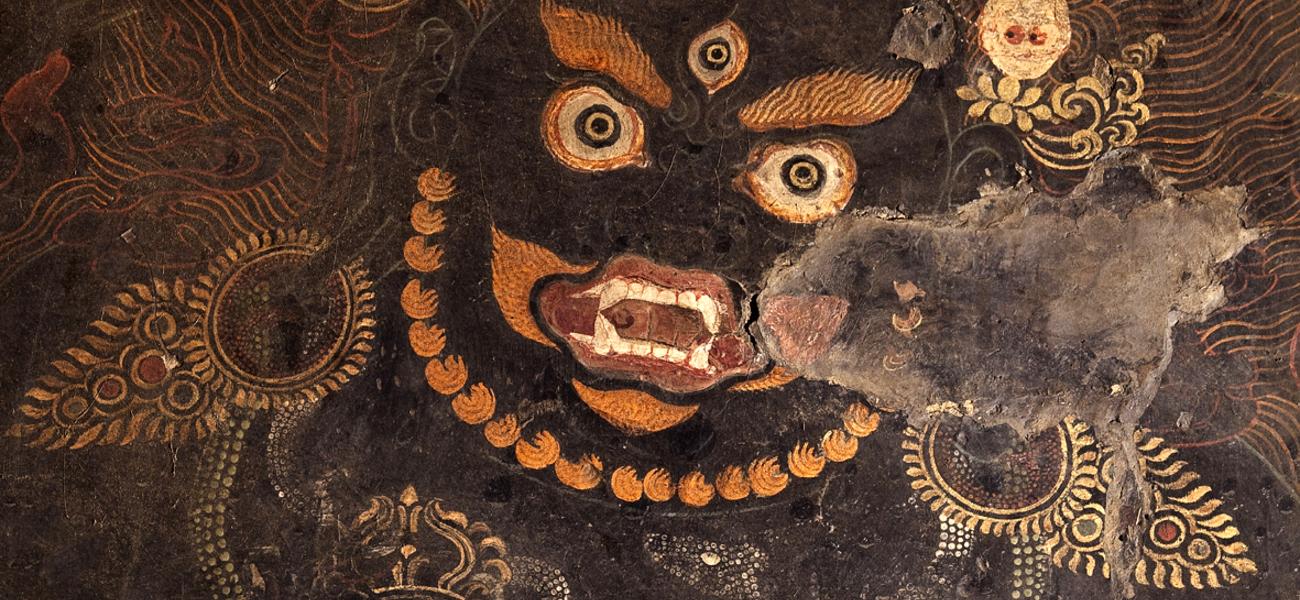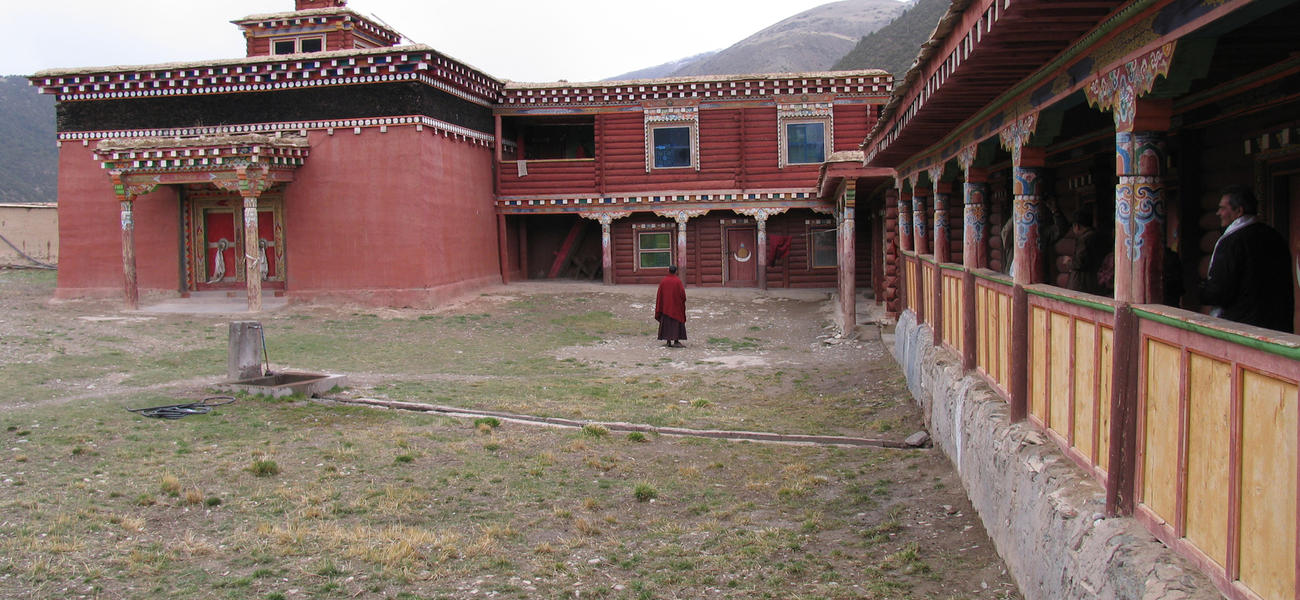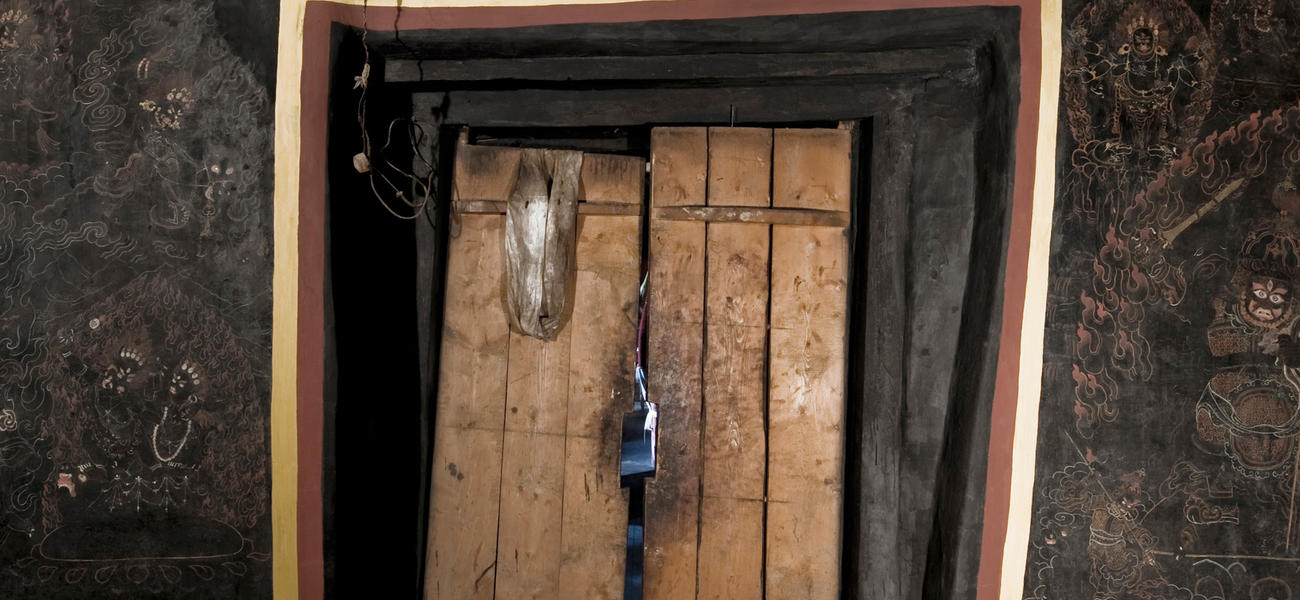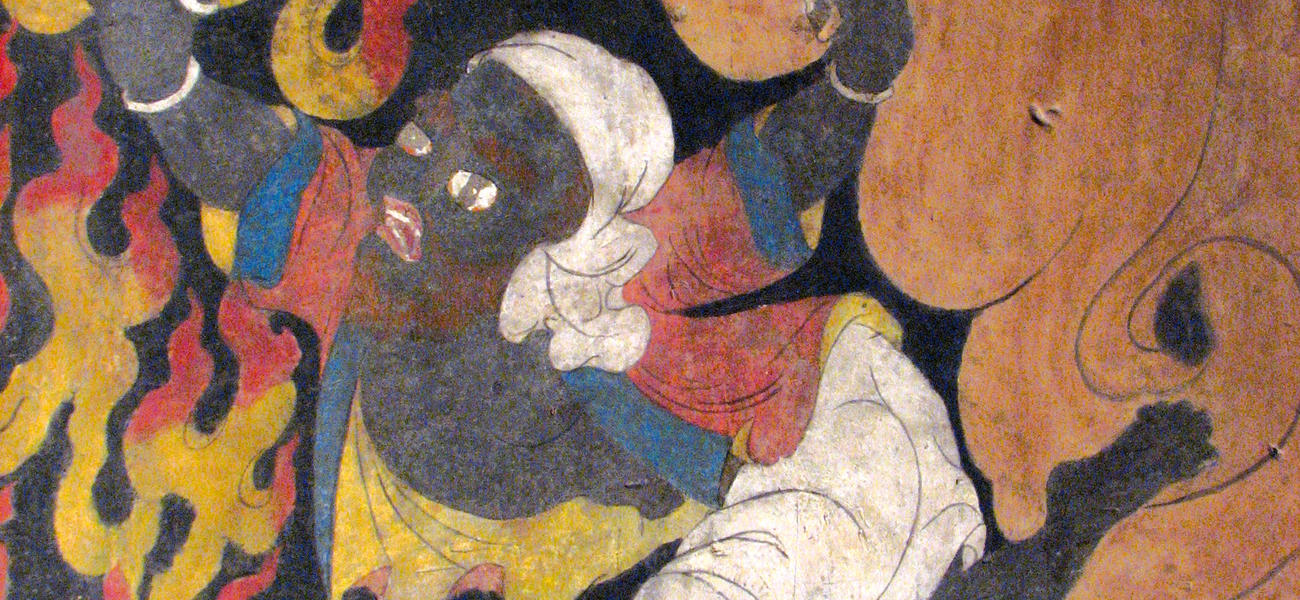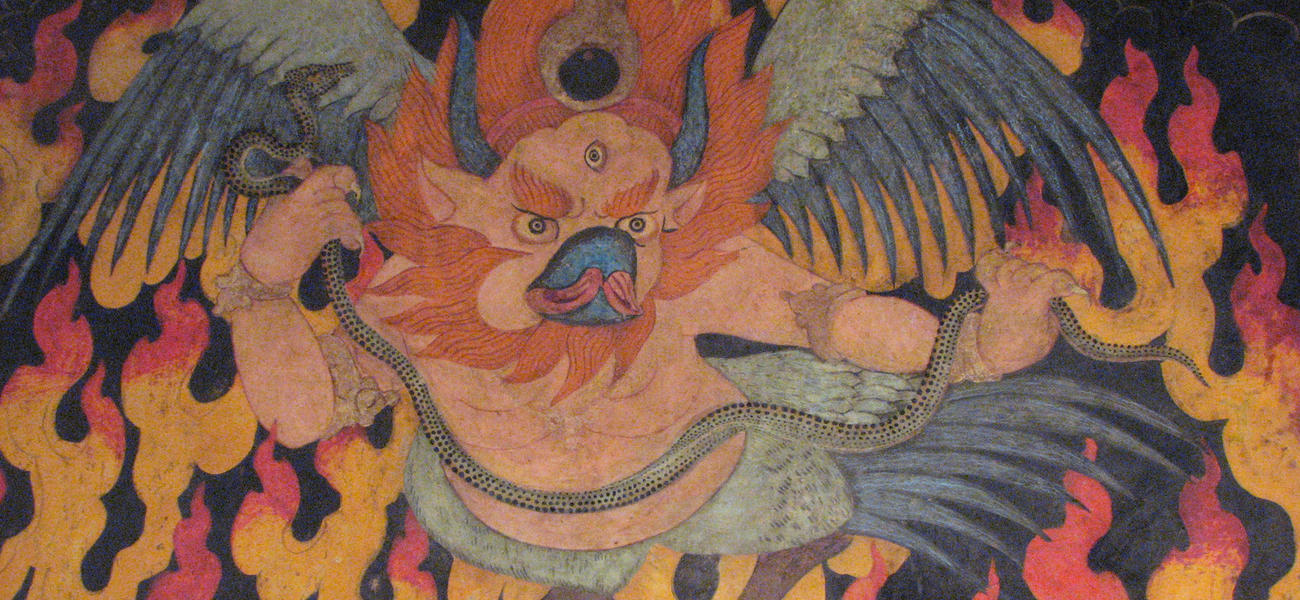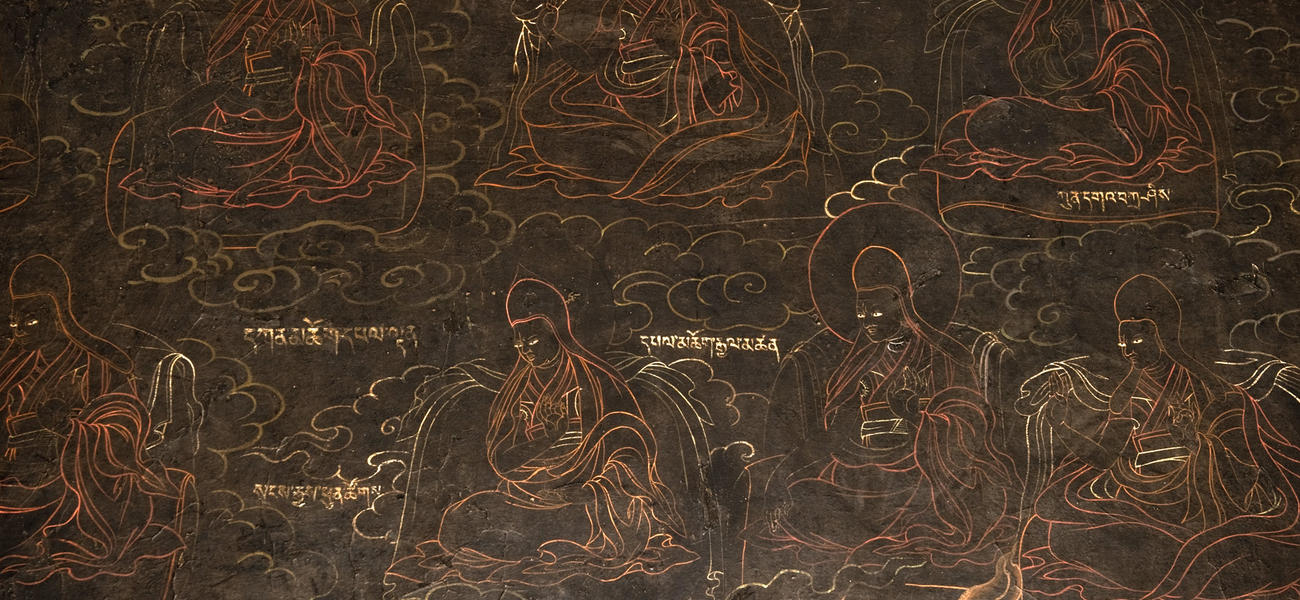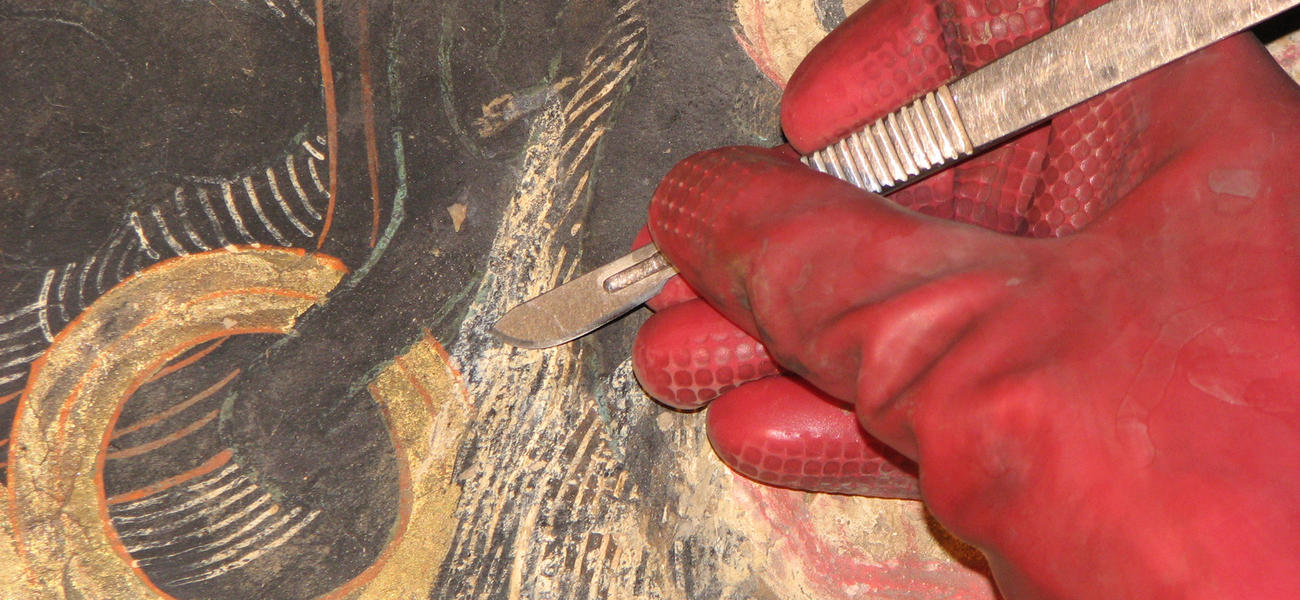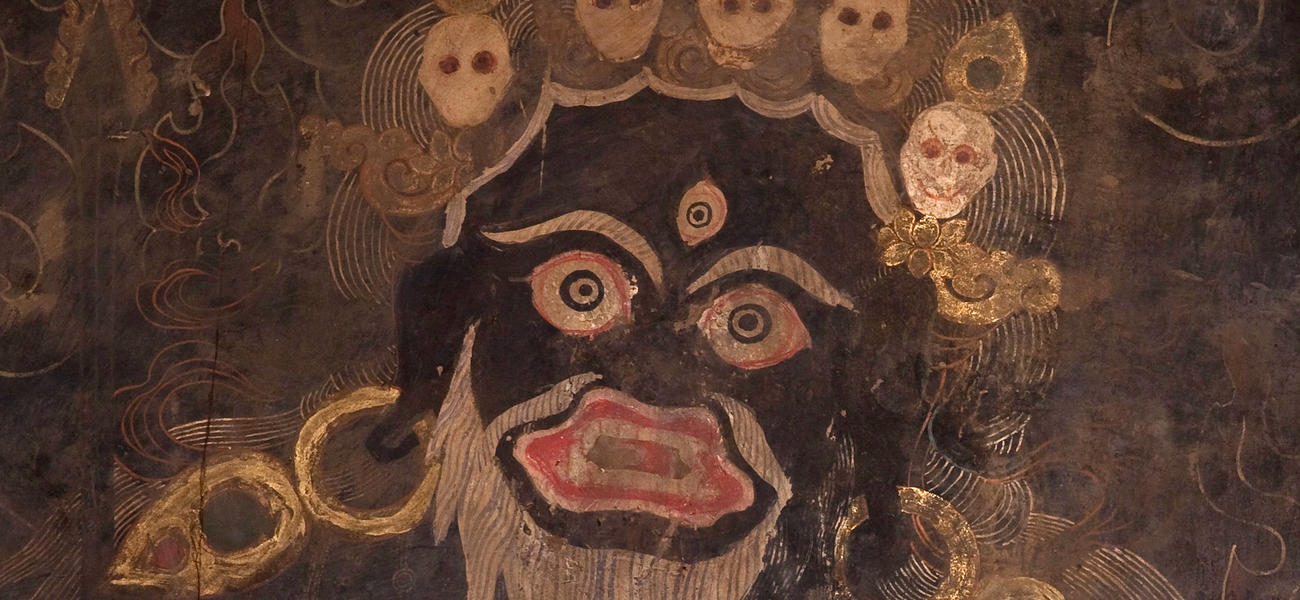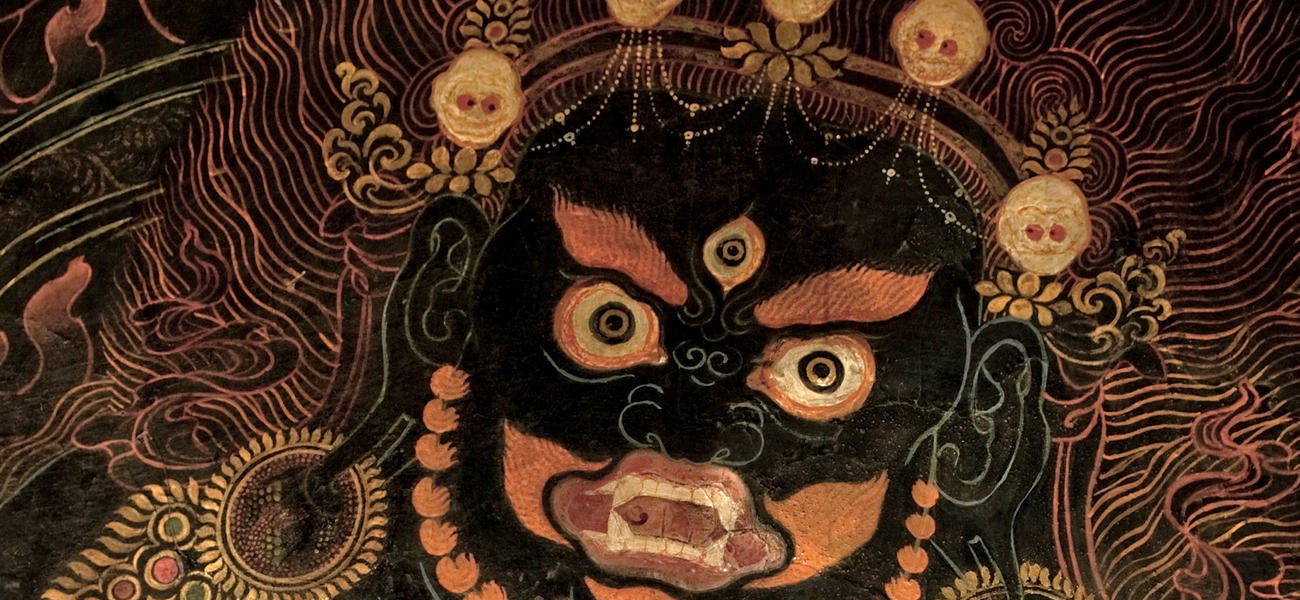In the dark, all that can be seen are the whites of their eyes.
Gradually they emerge from the blackness, an entire retinue of fanged demons, holding weapons of war, clothed in the skins of wild animals, and crowned with human heads. In the flickering light of the gönkhang in Galingteng, these wrathful protectors appear to dance along the black walls, still inspiring fear and reverence centuries after they were painted.
Galingteng lies just outside Derge Town, in Kardze Prefecture in the historic region of Kham. The small village is bisected by a river that winds it way out of the snowcapped mountains that are its source. The majority of the village’s inhabitants are nomadic herders whose winter homes lie along one side of the river, while the other side is home to a large monastic complex, known as Galing Gön. Unlike other Tibetan areas, where buildings are commonly made of whitewashed stone, the homes here are made of wood and clay and painted a deep ochre. Painted on many are red and white stripes on a grey background, marking the inhabitants as adherents of the Sakya school of Tibetan Buddhism.
Galing Gön lies at the heart of the community to which it has given its name. The first monastery in the area is said to have been built in the ninth century by Lhalung Pelgyi Dorje after he fled central Tibet to escape retribution for the assassination of Langdarma, the last Tibetan emperor. It was not Pelgyi Dorje however, but Ga Anyen Dampa, the famous student of Sakya Pandita, who would give the monastery its name. Though some hold that the name derives from when, returning from mainland China in the thirteenth century, Anyen Dampa unsaddled (galen – སྒ་ལེན། ) his horse here, the majority say that the name derives instead from his surname, Ga. It was Anyen Dampa who built the gönkhang in Galingteng and commissioned the murals of the eight principal protectors of the Sakya school that cover its walls.
Gönkhangs are a common feature of temples across Tibet. These temples are devoted to the wrathful protectors of dharma, and the destroyers of obstacles encountered on the path to spiritual enlightenment. Chief among them is Mahākāla (Nakpo Chenpo, ནག་པོ་ཆེན་པོ། ), the Great Black One, more commonly known as Gönpo, the Protector. The temples devoted to these protectors are commonly decorated with weapons, animal skins, and murals of wrathful deities painted on a deep black background.
The gönkhang at Galingteng was once a part of a much larger monastic complex. During the Cultural Revolution much of the complex was destroyed. The gönkhang, however, was converted into a granary and remained largely intact, though the years of neglect and the advanced age of the building eventually took their toll, particularly on the murals. In 2007, Trace Foundation provided support to restore the murals in the gönkhang at Galingteng. Trace supplied funding to send three restorers, Giulia Cervi, Sara Scioscia, and Emanuele Marconi to the site to analyze the extent of the damage and begin work on the restoration.
The gönkhang is a large rectangular room with a single window high in the wall opposite the door. The walls are roughly divided into two registers. The upper register is filled with garlands of human eyes and entrails, while the majority of the wall is given over to the depiction of wrathful deities. The murals are executed after the style of nakthangs, an ancient style of thangka painting in which the black bodies of wrathful deities are picked out from a black background by a gold line. Examples of this style of painting dating from the ninth century were found at the Dunhuang caves, but the style gained greater popularity only in the seventeenth to nineteenth centuries. Above each of the major deities are depicted, with a fine red line, the masters of the lineages that have transmitted the teachings tied to the worship of these deities.
The wall containing the entranceway is painted with murals of several different incarnations of Mahakala, as well as a large rendering of Bektse, a dharma protector ( ཆོས་སྐྱོང། ) depicted in the style of a Central Asian warrior. Moving clockwise through the room, the next wall bears two more representations of Mahakala, including Brahmarupa Mahakala. This incarnation of Mahakala as a dark-skinned brahmin with bared fangs, the wild hair and beard of an ascetic and a kangling (human femur trumpet) in hand arose due to the impropriety in Sakya school of showing an image of the four-faced (Caturmukha) Mahakala to the uninitiated. Further down on the same wall are the Citipati – a pair of dancing skeletons – and Makzor Gyelmo, Queen of the Army Repelling Weapons. This protector deity was first popularized by the Sakyapas, though her worship later spread to the Geluk school, where she became a special protector of the Dalai Lamas.
The central deity on the wall opposite the door is missing, represented instead by a halo of flame. Although rare, depictions of this type usually represent omnipresent enlightened activity able to manifest simultaneously wherever needed for the benefit of sentient beings. The animals amongst the flames, however, point clearly to Panjarnatha Mahakala, the main figure on the last wall. The aureole is further surrounded by diverse wrathful deities. Unlike the paintings on the other walls, which date uniformly from the eighteenth century, this wall reflects styles that were common in eastern Tibet in the latter half of the nineteenth century. The mural then covers an area that had most likely been previously used, and which had possibly undergone particular deterioration.
The entirety of the last wall is devoted to Panjarnatha Mahakala (Gur Gönpo), the special protector of the Sakya school. Commonly said to be the protector of the tent ( གུར། ), the Sakyapa textual tradition preserves the meaning of the original Sanskrit panjara: cage, mostly commonly taken to mean the cage of the body. This god of cemeteries, clad in a tiger skin and a diadem of skulls, represents, in a Buddhist context, the power to overcome the body within which one is trapped by ignorance. He is surrounded by a retinue of wrathful deities including Relchigma, Pelden Lhamo, and Chakne Dorje.
When the restorers arrived, large cracks and surface abrasions covered the painted walls. At some point in the past, the building had slid on its foundation, warping the doorway and baseboards, and detaching large segments of the painted surface, particularly near the corners. The murals had been further obscured by regular applications of yak butter and centuries of smoke from incense and butter lamps – the only light source, aside from the single small window, in the temple.
Making use of a large gas generator to light the space, the restorers began an analysis of the state of the temple, and the methods and materials used in its original construction. The gönkhang at Galingteng was constructed using traditional methods. The walls are made of clay and vegetable fibers, applied layer-by-layer and compressed to make a solid wall over 40 in (100 cm) thick. To prepare the wall for painting, a thin layer of kaolinite, the principal component of porcelain, was applied to the walls then burnished with river rocks to create a smooth surface to which paints could be applied.
The restorers began their work by repairing the painting surface. Using a mixture of local clay and a synthetic resin, the restorers filled the major cracks and gaps in the wall. Bits of paint that had flaked off from the original work were reapplied using the same resin. Once the painting surface had been restored, work commenced on cleaning all four walls. Using brushes, water and polar solvents, the restorers were able to remove the smoke and dirt deposits that had accumulated on the walls. In several places, previous restorations, using a coarsely applied plaster of local clay, covered the faces of the principle deities. These plasters were removed manually with a scalpel, allowing the restorers to work from the original.
Given the important religious function of the paintings, work focused on a full mimetic restoration, returning the images as closely as possible to their original state. Determined to make as great a use of traditional materials and methods as possible, the restorers took samples of the paints from the wall and sent them to the Institute of Surfaces and Inorganic Chemistry at the National Research Council in Padua, Italy. The painting style, derived from the Indo-Nepali tradition, relies on the use of tempera paints made from ground organic and mineral pigments bound in an animal-based (frequently yak) glue. In the case of the gönkhang, every wall had been coated in a layer of carbon black before the figures were painted on top. The paints used on the primary figures derive largely from crushed precious stones, including malachite, azurite, orpiment and cinnabar. The outline of the principle figures was achieved through a thin layer of gold leaf applied over orpiment.
In the course of just over two months the three restorers were able to complete their work in the temple. Turning off the gas generator that had lit their progress through the summer for the last time, and lighting a single yak butter candle, the restorers finally stepped back from the walls they had labored over, and took in a sight unseen for three centuries.
This story was based on reports made by Sara Bianchin, Giulia Cervi, Monica Favaro, Fillipo Lunardo, and Sara Scioscia in The Mahakala Temple of Galingteng: The Resoration of its Murals.

